
Am Fam Physician. 2012;86(7):643-649
Patient information: See related handout on acute stress disorder, written by the authors of this article.
Author disclosure: No relevant financial affiliations to disclose.
Acute stress disorder is a psychiatric diagnosis that may occur in patients within four weeks of a traumatic event. Features include anxiety, intense fear or helplessness, dissociative symptoms, reexperiencing the event, and avoidance behaviors. Persons with this disorder are at increased risk of developing posttraumatic stress disorder. Other risk factors for posttraumatic stress disorder include current or family history of anxiety or mood disorders, a history of sexual or physical abuse, lower cognitive ability, engaging in excessive safety behaviors, and greater symptom severity one to two weeks after the trauma. Common reactions to trauma include physical, mental, and emotional symptoms. Persistent psychological distress that is severe enough to interfere with psychological or social functioning may warrant further evaluation and intervention. Patients experiencing acute stress disorder may benefit from psychological first aid, which includes ensuring the patient’s safety; providing information about the event, stress reactions, and how to cope; offering practical assistance; and helping the patient to connect with social support and other services. Cognitive behavior therapy is effective in reducing symptoms and decreasing the future incidence of posttraumatic stress disorder. Critical Incident Stress Debriefing aims to mitigate emotional distress through sharing emotions about the traumatic event, providing education and tips on coping, and attempting to normalize reactions to trauma. However, this method may actually impede natural recovery by overwhelming victims. There is insufficient evidence to recommend the routine use of drugs in the treatment of acute stress disorder. Short-term pharmacologic intervention may be beneficial in relieving specific associated symptoms, such as pain, insomnia, and depression.
Acute stress disorder (ASD) is a psychiatric diagnosis that may occur in patients after witnessing, hearing about, or being directly exposed to a traumatic event, such as motor vehicle crashes, acts of violence (e.g., military combat, sexual assault, robbery), work-related injuries, natural or man-made disasters, or sudden and unexpected bad news (e.g., diagnosis of life-threatening illness, death of a loved one). Patients with ASD respond with intense fear, helplessness, or horror, and may report anxiety, depression, fatigue, headaches, and gastrointestinal and rheumatic symptoms.1
| Clinical recommendation | Evidence rating | References |
|---|---|---|
| Psychological first aid should be provided to patients who have acute stress disorder. | C | 1, 20, 24 |
| Cognitive behavior therapy is the most effective intervention in persons with acute stress disorder. | A | 1, 11, 20, 28–33 |
| Patients with acute stress should not routinely be provided with Critical Incident Stress Debriefing. | C | 1, 20 |
| Medication should not routinely be used in patients with acute stress disorder. | C | 11, 13 |
Epidemiology
Trauma is a common experience. It has been estimated that 50 to 90 percent of U.S. adults experience trauma during their lives.2,3 Many victims of trauma recover on their own; others do not. ASD affects 14 to 33 percent of persons exposed to severe trauma.4 This disorder has been reported in 25 percent of persons who have experienced robbery, life-threatening circumstances, or physical or psychological assault or captivity, and in persons who witnessed another being injured or killed.5 In addition, 21 percent of adults involved in motor vehicle crashes6 and 62 percent of Hurricane Katrina evacuees at an emergency shelter met criteria for ASD.7 ASD has also been reported in 19.4 percent of children and adolescents involved in assaults or motor vehicle crashes8 and in 14.6 percent of disaster workers after the September 11, 2001, terrorist attacks.9
Seven to 28 percent of trauma victims experience ASD and subsyndromal ASD (typically not including the dissociative criteria).10 Although persons who meet criteria for ASD are at increased risk of posttraumatic stress disorder (PTSD), most of those who eventually develop PTSD do not meet all of the criteria for ASD. Therefore, the value of ASD in predicting PTSD has been questioned.10
Diagnostic Criteria
The diagnostic criteria for ASD are listed in Table 1.4 Essential features include anxiety, dissociative symptoms, reexperiencing the event, and avoidance of stimuli that arouse recollections of the event. Symptoms must be present for a minimum of two days, but not longer than four weeks; patients with persistent symptoms should be assessed for PTSD. Symptoms of ASD typically peak in the days or weeks after a patient is exposed to trauma, then gradually decrease over time.11 ASD and PTSD share many core symptoms, but ASD includes dissociative symptoms such as detachment, reduced awareness of surroundings, derealization, depersonalization, and dissociative amnesia.4
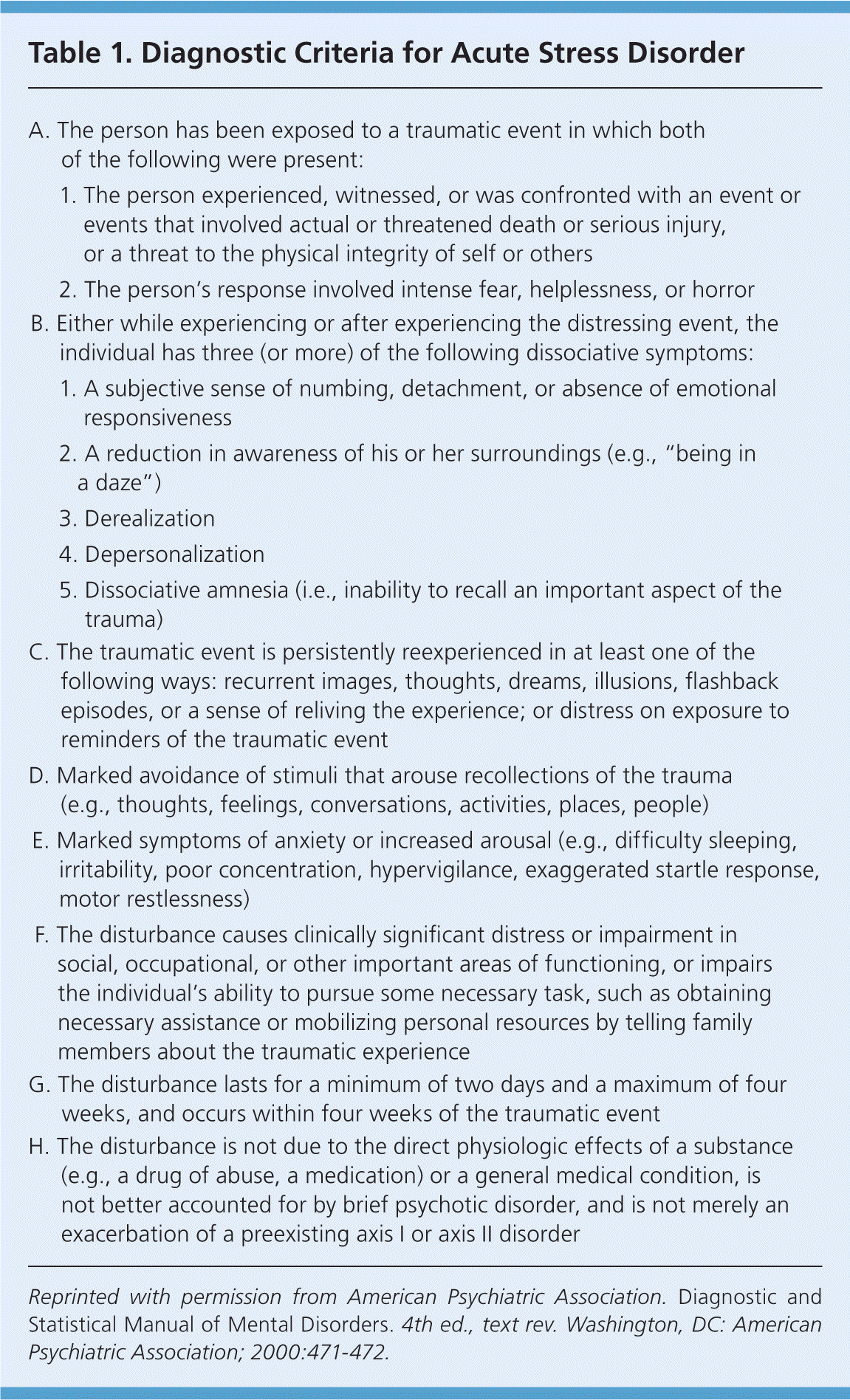
| A. The person has been exposed to a traumatic event in which both of the following were present: | |
| 1. The person experienced, witnessed, or was confronted with an event or events that involved actual or threatened death or serious injury, or a threat to the physical integrity of self or others | |
| 2. The person’s response involved intense fear, helplessness, or horror | |
| B. Either while experiencing or after experiencing the distressing event, the individual has three (or more) of the following dissociative symptoms: | |
| 1. A subjective sense of numbing, detachment, or absence of emotional responsiveness | |
| 2. A reduction in awareness of his or her surroundings (e.g., “being in a daze”) | |
| 3. Derealization | |
| 4. Depersonalization | |
| 5. Dissociative amnesia (i.e., inability to recall an important aspect of the trauma) | |
| C. The traumatic event is persistently reexperienced in at least one of the following ways: recurrent images, thoughts, dreams, illusions, flashback episodes, or a sense of reliving the experience; or distress on exposure to reminders of the traumatic event | |
| D. Marked avoidance of stimuli that arouse recollections of the trauma (e.g., thoughts, feelings, conversations, activities, places, people) | |
| E. Marked symptoms of anxiety or increased arousal (e.g., difficulty sleeping, irritability, poor concentration, hypervigilance, exaggerated startle response, motor restlessness) | |
| F. The disturbance causes clinically significant distress or impairment in social, occupational, or other important areas of functioning, or impairs the individual’s ability to pursue some necessary task, such as obtaining necessary assistance or mobilizing personal resources by telling family members about the traumatic experience | |
| G. The disturbance lasts for a minimum of two days and a maximum of four weeks, and occurs within four weeks of the traumatic event | |
| H. The disturbance is not due to the direct physiologic effects of a substance (e.g., a drug of abuse, a medication) or a general medical condition, is not better accounted for by brief psychotic disorder, and is not merely an exacerbation of a preexisting axis I or axis II disorder | |
Assessment
Not all trauma victims want or need professional assistance. Those who refuse help may not be in denial, but may see themselves as more resilient or able to rely on the support of family and friends. Physicians should support patients who want to talk about their experience, but not push those who prefer not to.12 Early identification and management of ASD can decrease the percentage of patients who develop PTSD.13
Within minutes of a traumatic event, persons may develop an acute stress reaction. This is a transient condition involving a broad array of signs and symptoms, including depression, anxiety, fatigue, difficulties with concentration and memory, hyperarousal, and social withdrawal. These occur at the same time as or within a few minutes of the traumatic event, and in most cases disappear within hours or days.11 Patients with traumatic stress often present with general symptoms, such as headaches, gastrointestinal disorders, rheumatic pain, skin disorders, difficulty sleeping, cardiovascular symptoms,1,14 or psychological problems (e.g., anxiety, depression).15
Risk factors for PTSD should also be assessed (Table 2).16–20 Patients who have experienced trauma may not report it to their physician, but instead may present with a range of disorders, including depressed mood, anger, sleep problems, and physical symptoms. Therefore, physicians are encouraged to ask the patient about trauma or recent stressful events.12 Patients who have experienced trauma should also be evaluated to determine whether they are a danger to themselves or others.11,12
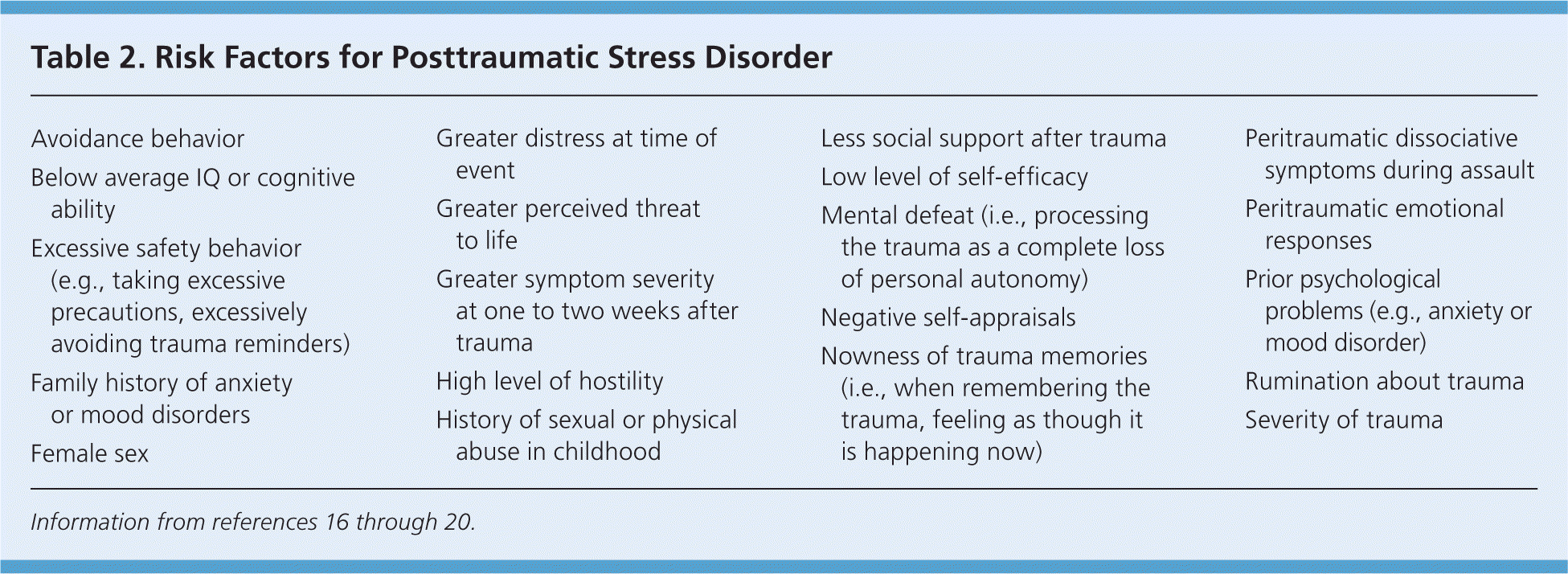
| Avoidance behavior |
| Below average IQ or cognitive ability |
| Excessive safety behavior (e.g., taking excessive precautions, excessively avoiding trauma reminders) |
| Family history of anxiety or mood disorders |
| Female sex |
| Greater distress at time of event |
| Greater perceived threat to life |
| Greater symptom severity at one to two weeks after trauma |
| High level of hostility |
| History of sexual or physical abuse in childhood |
| Less social support after trauma |
| Low level of self-efficacy |
| Mental defeat (i.e., processing the trauma as a complete loss of personal autonomy) |
| Negative self-appraisals |
| Nowness of trauma memories (i.e., when remembering the trauma, feeling as though it is happening now) |
| Peritraumatic dissociative symptoms during assault |
| Peritraumatic emotional responses |
| Prior psychological problems (e.g., anxiety or mood disorder) |
| Rumination about trauma |
| Severity of trauma |
In addition to using diagnostic criteria to assess for ASD, physicians may use self-report instruments such as the Acute Stress Disorder Scale (see appendix at http://psych.on.ca/files/nonmembers/AcuteStressDisorderScale_DRN_March_5_2010.pdf). This is a 19-item inventory based on the Acute Stress Disorder Interview 21 and designed to assist physicians in the diagnosis of ASD. It covers the major symptoms of ASD and has been proven reliable and valid. A cut-off score based on a cluster of items shows a sensitivity of 95 percent and a specificity of 83 percent for the diagnosis of ASD. The Acute Stress Disorder Scale also has high sensitivity (91 percent) and specificity (93 percent) for predicting PTSD; however, 33 percent of persons identified as being at risk did not develop PTSD.22 The scale is scored by totaling the ratings from the 19 items. Each item is rated on a five-point scale, with total scores ranging from 19 to 95. The authors recommend a cutoff score of 56.22
Initial Management
The management of ASD involves normalizing the patient’s responses, providing psychological first aid, and monitoring the patient over time. Referral to a psychologist or psychiatrist may be necessary if symptoms worsen or persist.
NORMALIZING PATIENT RESPONSES
It is helpful to assist the patient in understanding that acute responses to trauma are common and often transient, and are not a sign of mental illness. Encouraging positive ways to cope and providing resources (e.g., http://www.nimh.nih.gov/health/topics/post-traumatic-stress-disorder-ptsd/index.shtml, http://www.ptsd.va.gov/public/pages/acute-stress-disorder.asp) may also be helpful. Patients may benefit from education on coping with acute responses (e.g., sleep problems, hyperarousal, pain) in the form of counseling, handouts, or referral to a psychologist or psychiatrist.11,12
PSYCHOLOGICAL FIRST AID
Psychological first aid is thought to be the most appropriate intervention for persons experiencing distress or decrements in functioning immediately after trauma.23,24 It is an evidence-informed intervention that includes eight core actions: (1) making contact with and engaging the patient, (2) ensuring the patient’s safety and comfort, (3) providing stabilization, (4) gathering information about current needs and concerns, (5) providing practical assistance with immediate needs and concerns, (6) connecting the patient with social and other types of support, (7) providing information about stress reactions and coping to reduce distress and promote appropriate coping, and (8) linking the patient to collaborative services, with emphasis on using local resources to ensure that services are culturally and regionally appropriate (Table 3).1,11,23,25,26
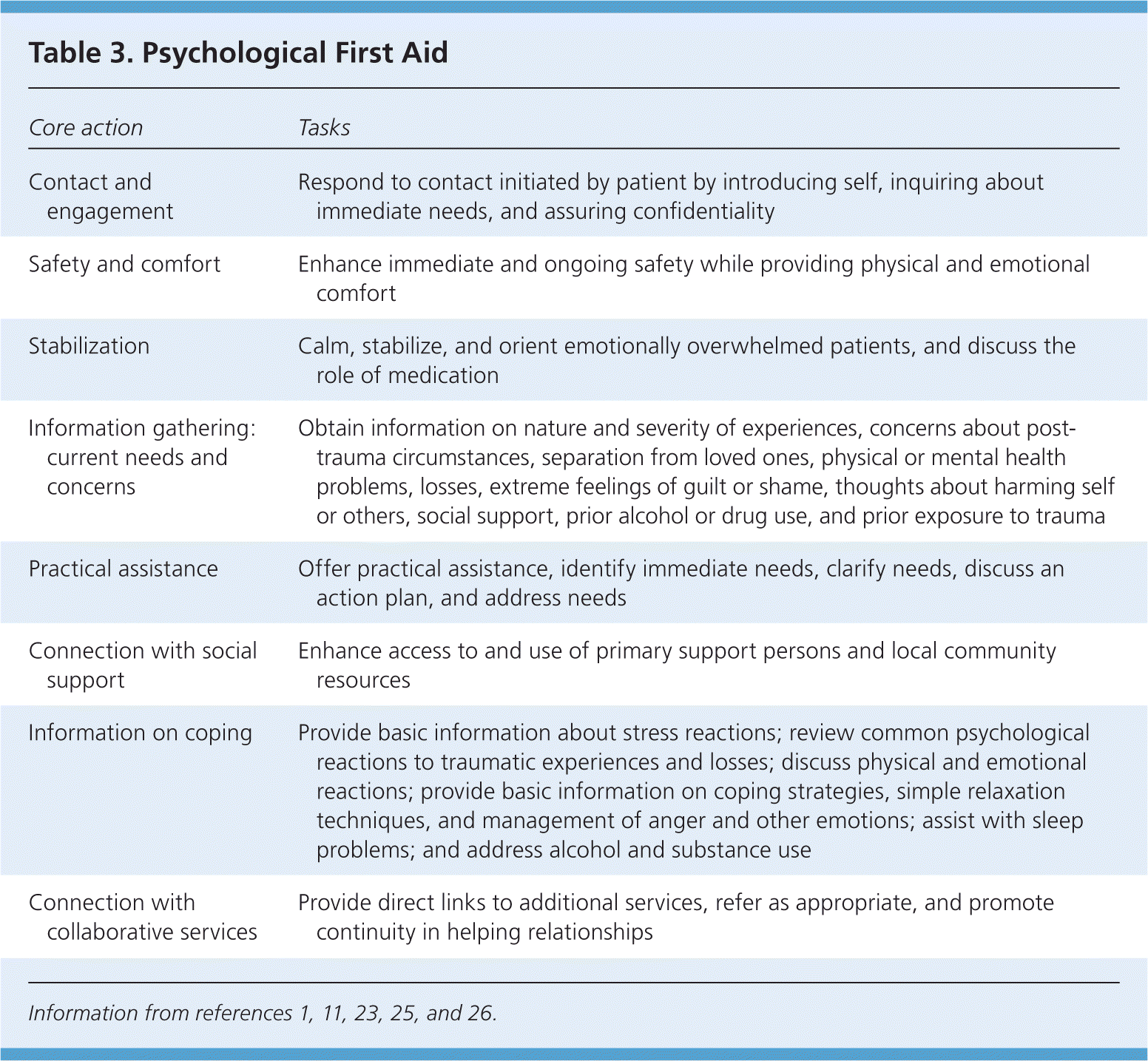
| Core action | Tasks |
|---|---|
| Contact and engagement | Respond to contact initiated by patient by introducing self, inquiring about immediate needs, and assuring confidentiality |
| Safety and comfort | Enhance immediate and ongoing safety while providing physical and emotional comfort |
| Stabilization | Calm, stabilize, and orient emotionally overwhelmed patients, and discuss the role of medication |
| Information gathering: current needs and concerns | Obtain information on nature and severity of experiences, concerns about post-trauma circumstances, separation from loved ones, physical or mental health problems, losses, extreme feelings of guilt or shame, thoughts about harming self or others, social support, prior alcohol or drug use, and prior exposure to trauma |
| Practical assistance | Offer practical assistance, identify immediate needs, clarify needs, discuss an action plan, and address needs |
| Connection with social support | Enhance access to and use of primary support persons and local community resources |
| Information on coping | Provide basic information about stress reactions; review common psychological reactions to traumatic experiences and losses; discuss physical and emotional reactions; provide basic information on coping strategies, simple relaxation techniques, and management of anger and other emotions; assist with sleep problems; and address alcohol and substance use |
| Connection with collaborative services | Provide direct links to additional services, refer as appropriate, and promote continuity in helping relationships |
MONITORING AND REFERRAL
Physicians should closely monitor physical and psychological symptoms of all patients who have experienced trauma. Although most trauma survivors recover without any formal professional help,20 a significant number benefit from psychological or psychiatric assistance. Physicians should refer patients who have prolonged reactions that cause distress or affect interpersonal relationships and daily functioning. In addition, it is important to follow up with survivors of trauma because problems may not resolve, new problems may develop, and relapse may occur.27
Specific Therapies
COGNITIVE BEHAVIOR THERAPY
Although limited evidence exists for providing direct psychological intervention within the first month after trauma, the use of cognitive behavior therapy (CBT) has been supported in situations where the threat has subsided and stability has returned.1,11,20,27 Typically, CBT includes education about posttraumatic reactions, progressive muscle relaxation training, imagined exposure to the traumatic memory, cognitive restructuring of distorted trauma-related beliefs, and graduated exposure to situations avoided by the patient. CBT alone or in combination with hypnosis is more effective than supportive counseling in preventing PTSD in mixed-trauma patients with ASD, and effects are generally maintained over three years.28,29 Imagined and in vivo exposure were found to be more effective than wait-list control or cognitive restructuring in preventing PTSD.30
Overall, CBT is the most effective intervention for reducing symptoms and decreasing the future incidence of PTSD.28–33 The following intervention principles are empirically supported and may be used to guide prevention efforts and intervention practices in persons who have experienced trauma: promoting a sense of safety, promoting a sense of calm, promoting a sense of self-efficacy and collective efficacy, promoting connectedness, and instilling hope (Table 4).34
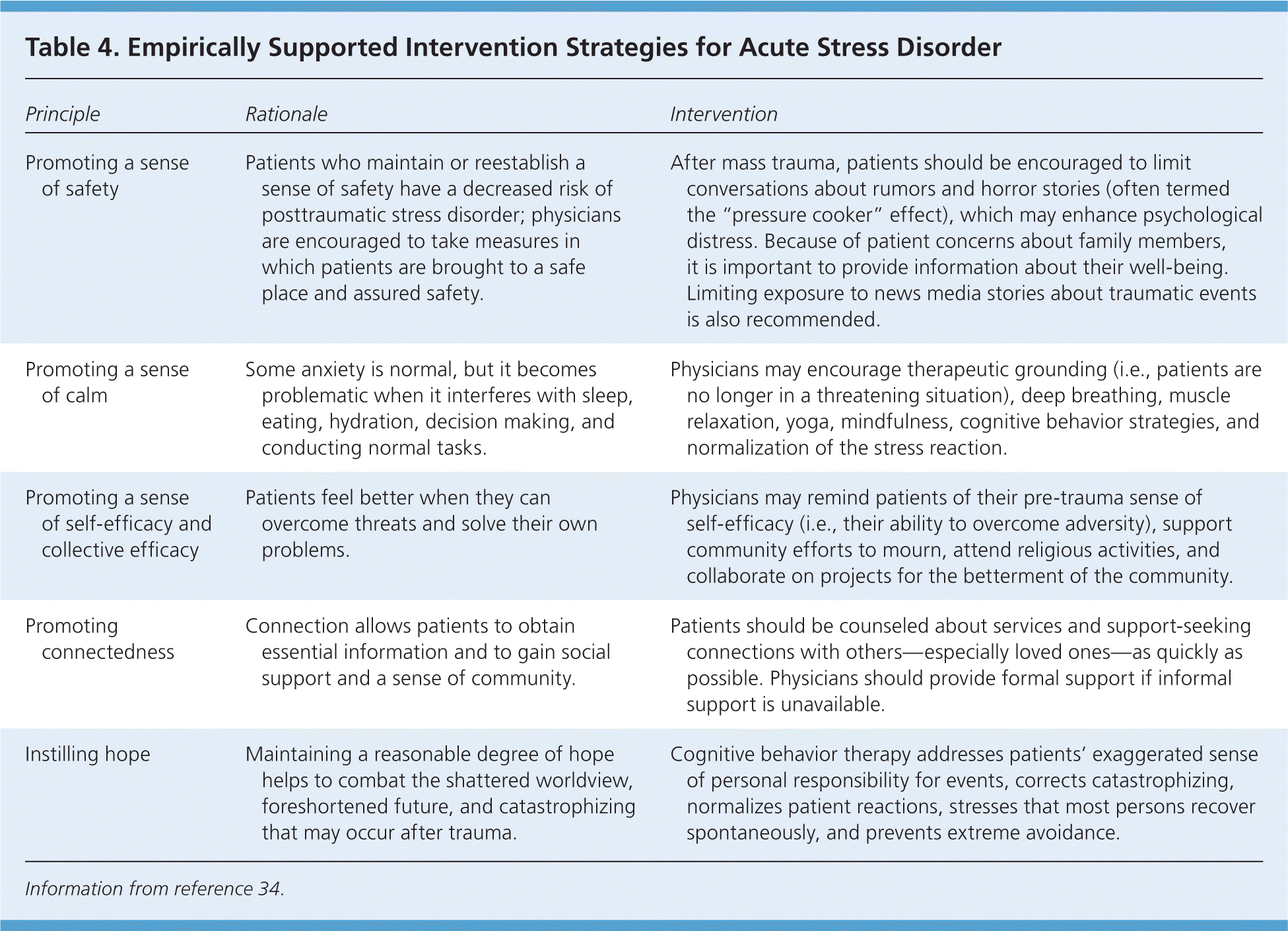
| Principle | Rationale | Intervention |
|---|---|---|
| Promoting a sense of safety | Patients who maintain or reestablish a sense of safety have a decreased risk of posttraumatic stress disorder; physicians are encouraged to take measures in which patients are brought to a safe place and assured safety. | After mass trauma, patients should be encouraged to limit conversations about rumors and horror stories (often termed the “pressure cooker” effect), which may enhance psychological distress. Because of patient concerns about family members, it is important to provide information about their well-being. Limiting exposure to news media stories about traumatic events is also recommended. |
| Promoting a sense of calm | Some anxiety is normal, but it becomes problematic when it interferes with sleep, eating, hydration, decision making, and conducting normal tasks. | Physicians may encourage therapeutic grounding (i.e., patients are no longer in a threatening situation), deep breathing, muscle relaxation, yoga, mindfulness, cognitive behavior strategies, and normalization of the stress reaction. |
| Promoting a sense of self-efficacy and collective efficacy | Patients feel better when they can overcome threats and solve their own problems. | Physicians may remind patients of their pre-trauma sense of self-efficacy (i.e., their ability to overcome adversity), support community efforts to mourn, attend religious activities, and collaborate on projects for the betterment of the community. |
| Promoting connectedness | Connection allows patients to obtain essential information and to gain social support and a sense of community. | Patients should be counseled about services and support-seeking connections with others—especially loved ones—as quickly as possible. Physicians should provide formal support if informal support is unavailable. |
| Instilling hope | Maintaining a reasonable degree of hope helps to combat the shattered worldview, foreshortened future, and catastrophizing that may occur after trauma. | Cognitive behavior therapy addresses patients’ exaggerated sense of personal responsibility for events, corrects catastrophizing, normalizes patient reactions, stresses that most persons recover spontaneously, and prevents extreme avoidance. |
PSYCHOLOGICAL DEBRIEFING
Psychological debriefing is a short intervention provided immediately after a person has experienced trauma. Critical Incident Stress Debriefing is a widely used version that is often part of a multicomponent program.35 It is typically delivered in a group setting two to 10 days after a traumatic event and is meant to mitigate emotional distress by allowing patients to share emotions about the event, providing education and tips on coping, and attempting to normalize patients' reactions to trauma. However, most studies that have shown benefits have methodologic limitations. It appears that use of Critical Incident Stress Debriefing at best results in no effect and at worst harms participants by impeding natural recovery. Therefore, this practice is not warranted.1,20
PHARMACOLOGIC MANAGEMENT
Few studies have evaluated the pharmacologic treatment of ASD. In a retrospective study, imipramine (Tofranil) or fluoxetine (Prozac) relieved ASD-associated symptoms in 81 and 75 percent, respectively, of children with ASD following burn injuries.36 However, in a follow-up double-blind clinical trial, these agents provided no greater relief than placebo among 60 patients four to 18 years of age with ASD secondary to major burns.37 When administered after a stressful event, the beta blocker propranolol has been shown to decrease PTSD and fear associated with reexposure.38–40 However, propranolol has not been shown to reduce the risk of ASD.41 The atypical antipsychotic risperidone (Risperdal) seems promising for acute treatment of ASD. In a retrospective study of 10 adults who had ASD after a burn injury, all reported symptom improvement (i.e., sleep, nightmares, hyperarousal, and thought recurrences) after as few as two doses.32,42
Currently, there is insufficient evidence to recommend the routine use of pharmacologic measures for the treatment of ASD, and there is clearly no support for drug therapy instead of CBT.11,13 In patients who are unable to participate in CBT, a trial of medication may be warranted. Short-term (less than six weeks) pharmacologic intervention may be beneficial in relieving targeted specific symptoms associated with the event (e.g., pain, insomnia, depression).12 Table 5 provides a summary of ASD resources available to physicians.
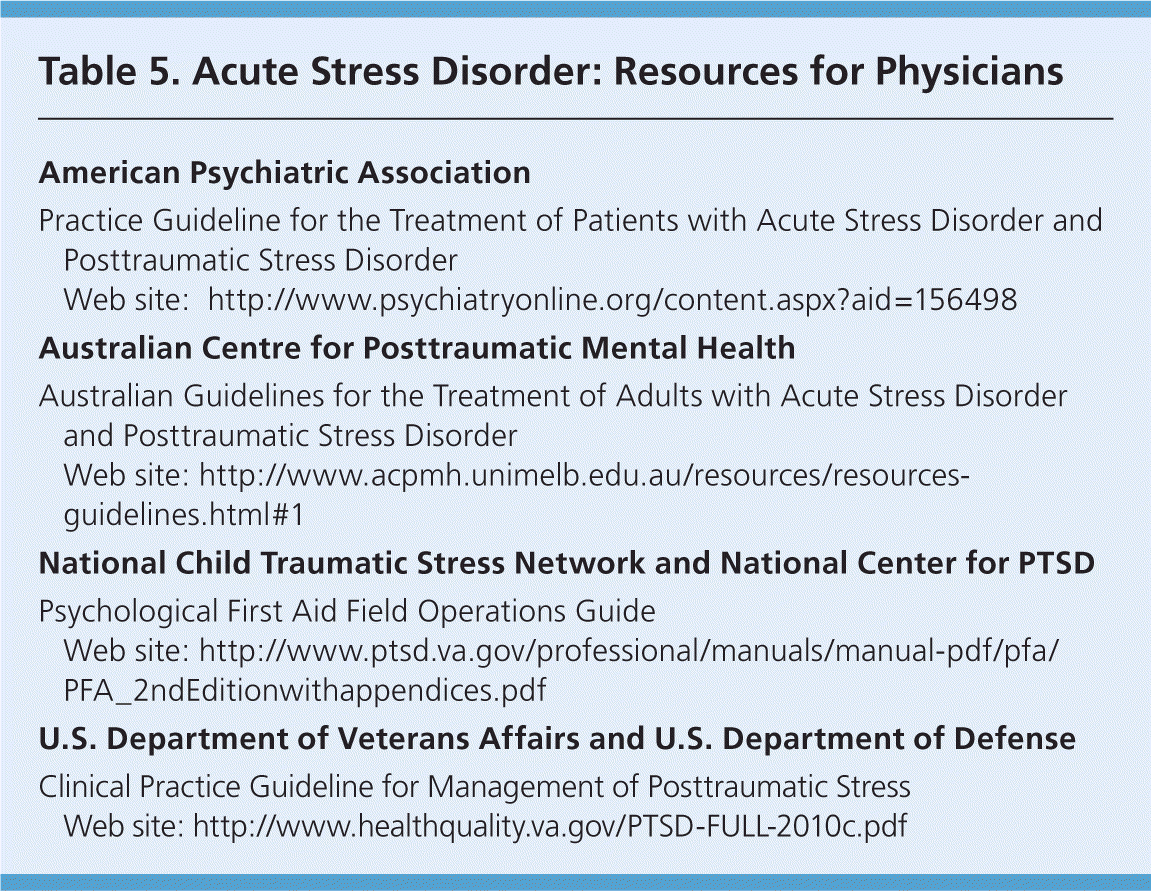
| American Psychiatric Association | |
| Practice Guideline for the Treatment of Patients with Acute Stress Disorder and Posttraumatic Stress Disorder | |
| Web site: http://www.psychiatryonline.org/content.aspx?aid=156498 | |
| Australian Centre for Posttraumatic Mental Health | |
| Australian Guidelines for the Treatment of Adults with Acute Stress Disorder and Posttraumatic Stress Disorder | |
| Web site: http://www.acpmh.unimelb.edu.au/resources/resources-guidelines.html#1 | |
| National Child Traumatic Stress Network and National Center for PTSD | |
| Psychological First Aid Field Operations Guide | |
| Web site: http://www.ptsd.va.gov/professional/manuals/manual-pdf/pfa/PFA_2ndEditionwithappendices.pdf | |
| U.S. Department of Veterans Affairs and U.S. Department of Defense | |
| Clinical Practice Guideline for Management of Posttraumatic Stress | |
| Web site: http://www.healthquality.va.gov/PTSD-FULL-2010c.pdf | |
Data Sources: EBSCO Host and PubMed searches were completed using the key term acute stress disorder separately and in combination with assessment, diagnosis, management, treatment, and clinical practice guidelines. The searches included meta-analyses, clinical trials, randomized controlled trials, reviews, and clinical practice guidelines. We also searched the National Institute of Mental Health, Essential Evidence Plus, Cochrane, and the National Guideline Clearinghouse databases using the key term stress disorder alone and in combination with post-traumatic and traumatic. Original search dates were March 18, 2011, and April 1, 2011, with periodic updates; the last search date was September 9, 2011.
